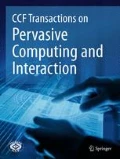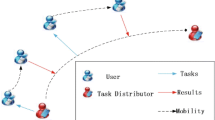Abstract
Mobile crowd sensing (MCS) is an attractive and innovation paradigm in which a crowd of users equipped with smart mobile devices conduct sensing tasks by fully exploiting their carried diverse embedded sensors. With the development of robots and Artificial Intelligence, many MCS studies with pervasive machines (Yu et al. Commun ACM 64:76–80, 2021) (e.g., unmanned vehicles, drones, etc.) as participants have emerged in recent years. Compared to human participants, robot participants have the advantages of being able to perform dangerous and boring tasks, being highly controlled, and not requiring complex incentive mechanisms. However, participants in previous studies usually have only one type of robot, and the use of heterogeneous robots for collaborative sensing was not considered. Second, previous studies have not considered the vulnerability of robots in realistic environments. In this paper, a multi-agent mobile crowdsensing (MA-MCS) system consisting of multiple heterogeneous robots is proposed to address the above two problems, and the task allocation problem of this system is investigated. To enable the robots to overcome the complex real-world environment, this paper proposes the concept of sense area information map (SAIM) and a self-repairing task allocation algorithm based on the information map. The SAIM can reflect the performance of different robots performing sense tasks in different locations and at different times, and provide guidance for task allocation. The self-repairing task assignment algorithm can be used to repair and reassign tasks after the robot has encountered abnormal situations. Through experiments, it is demonstrated that the SAIM and the map-based self-repairing task allocation algorithm can effectively improve task coverage at the expense of certain energy consumption.














Similar content being viewed by others
References
Campbell, A.T., Eisenman, S.B., Lane, N.D., Miluzzo, E., Peterson, R.A., Lu, H., Zheng, X., Musolesi, M., Fodor, K., Ahn, G.-S.: The rise of people-centric sensing. IEEE Internet Comput. 12(4), 12–21 (2008)
Gao, H., Liu, C.H., Tang, J., Yang, D., Hui, P., Wang, W.: Online quality-aware incentive mechanism for mobile crowd sensing with extra bonus. IEEE Trans. Mob. Comput. 18(11), 2589–2603 (2018)
Gao, G., Xiao, M., Wu, J., Huang, L., Hu, C.: Truthful incentive mechanism for nondeterministic crowdsensing with vehicles. IEEE Trans. Mob. Comput. 17(12), 2982–2997 (2018)
Guo, B., Wang, Z., Yu, Z., Wang, Y., Yen, N.Y., Huang, R., Zhou, X.: Mobile crowd sensing and computing: the review of an emerging human-powered sensing paradigm. ACM Comput. Surveys (CSUR) 48(1), 1–31 (2015)
He, S., Shin, D.-H., Zhang, J., Chen, J., Lin, P.: An exchange market approach to mobile crowdsensing: pricing, task allocation, and walrasian equilibrium. IEEE J. Sel. Areas Commun. 35(4), 921–934 (2017)
Karaliopoulos, M., Telelis, O., Koutsopoulos, I.: User recruitment for mobile crowdsensing over opportunistic networks. In: 2015 IEEE Conference on Computer Communications (INFOCOM), pp. 2254–2262. IEEE (2015)
Ko, H., Pack, S., Leung, V.C.: Coverage-guaranteed and energy-efficient participant selection strategy in mobile crowdsensing. IEEE Internet Things J. 6(2), 3202–3211 (2018)
Li, L., Ota, K., Dong, M.: Human in the loop: distributed deep model for mobile crowdsensing. IEEE Internet Things J. 5(6), 4957–4964 (2018)
Liu, W., Yang, Y., Wang, E., Wu, J.: User recruitment for enhancing data inference accuracy in sparse mobile crowdsensing. IEEE Internet Things J. 7(3), 1802–1814 (2019)
Liu, C.H., Dai, Z., Yang, H., Tang, J.: Multi-task-oriented vehicular crowdsensing: A deep learning approach. In: IEEE INFOCOM 2020-IEEE Conference on Computer Communications, pp. 1123–1132. IEEE (2020)
Piao, C., Liu, C.H.: Energy-efficient mobile crowdsensing by unmanned vehicles: a sequential deep reinforcement learning approach. IEEE Internet Things J. 7(7), 6312–6324 (2019)
Wang, E., Yang, Y., Wu, J., Liu, W., Wang, X.: An efficient prediction-based user recruitment for mobile crowdsensing. IEEE Trans. Mob. Comput. 17(1), 16–28 (2017)
Wang, L., Yu, Z., Zhang, D., Guo, B., Liu, C.H.: Heterogeneous multi-task assignment in mobile crowdsensing using spatiotemporal correlation. IEEE Trans. Mob. Comput. 18(1), 84–97 (2018)
Xiao, M., Wu, J., Huang, L., Wang, Y., Liu, C.: Multi-task assignment for crowdsensing in mobile social networks. In: 2015 IEEE Conference on Computer Communications (INFOCOM), pp. 2227–2235. IEEE (2015)
Xiao, M., Wu, J., Huang, L., Cheng, R., Wang, Y.: Online task assignment for crowdsensing in predictable mobile social networks. IEEE Trans. Mob. Comput. 16(8), 2306–2320 (2016)
Yang, G., He, S., Shi, Z., Chen, J.: Promoting cooperation by the social incentive mechanism in mobile crowdsensing. IEEE Commun. Mag. 55(3), 86–92 (2017)
Yang, S., Han, K., Zheng, Z., Tang, S., Wu, F.: Towards personalized task matching in mobile crowdsensing via fine-grained user profiling. In: IEEE INFOCOM 2018-IEEE Conference on Computer Communications, pp. 2411–2419. IEEE (2018)
Yang, S., Xu, C., Qiu, X., Wu, D.O.: Diffusion kalman filter with quantized information exchange in distributed mobile crowdsensing. IEEE Internet Things J. 6(3), 4423–4435 (2018)
Yu, T.-Y., Zhu, X., Chen, H.: Gosense: Efficient vehicle selection for user defined vehicular crowdsensing. In: 2017 IEEE 85th Vehicular Technology Conference (VTC Spring), pp. 1–5. IEEE (2017)
Yu, Z., Ma, H., Guo, B., Yang, Z.: Crowdsensing 2.0. Commun. ACM 64(11), 76–80 (2021)
Zhang, B., Liu, C.H., Tang, J., Xu, Z., Ma, J., Wang, W.: Learning-based energy-efficient data collection by unmanned vehicles in smart cities. IEEE Trans. Ind. Inf. 14(4), 1666–1676 (2017)
Zhou, Z., Feng, J., Gu, B., Ai, B., Mumtaz, S., Rodriguez, J., Guizani, M.: When mobile crowd sensing meets uav: Energy-efficient task assignment and route planning. IEEE Trans. Commun. 66(11), 5526–5538 (2018)
Acknowledgements
This work was supported in part by the National Key R&D Program of China (No. 2019YFB2102200), the National Science Fund for Distinguished Young Scholars (No. 61725205), the National Natural Science Foundation of China (No. 61960206008, No. 61772428, and No. 62002294), Natural Science Basic Research Program of Shaanxi (No. 2020JQ-215), and the Fundamental Research Funds for the Central Universities (No. 3102019QD1001).
Author information
Authors and Affiliations
Corresponding author
Rights and permissions
About this article
Cite this article
Luo, Y., Yu, Z., Yin, H. et al. Multi-agent mobile crowdsensing by pervasive machines: a robust task allocation approach. CCF Trans. Pervasive Comp. Interact. 5, 13–30 (2023). https://doi.org/10.1007/s42486-022-00104-7
Received:
Accepted:
Published:
Issue Date:
DOI: https://doi.org/10.1007/s42486-022-00104-7




